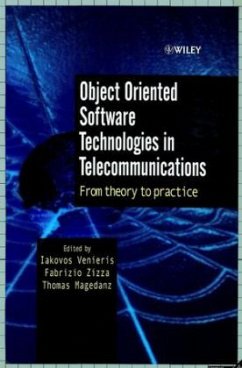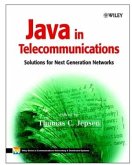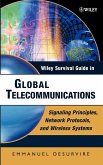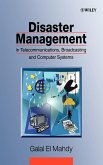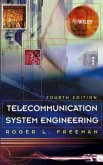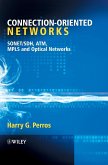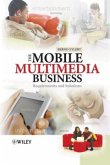Iakovos Venieris / Fabrizio Zizza / Thomas Magedanz (Hgg.)From Theory to Practice
Object Oriented Software Technologies in Telecommunications
From Theory to Practice
Herausgegeben:Venieris, Iakovos; Zizza, Fabrizio; Magedanz, Thomas
Iakovos Venieris / Fabrizio Zizza / Thomas Magedanz (Hgg.)From Theory to Practice
Object Oriented Software Technologies in Telecommunications
From Theory to Practice
Herausgegeben:Venieris, Iakovos; Zizza, Fabrizio; Magedanz, Thomas
- Gebundenes Buch
- Merkliste
- Auf die Merkliste
- Bewerten Bewerten
- Teilen
- Produkt teilen
- Produkterinnerung
- Produkterinnerung
Hier werden die Grundlagen der objektorientierten Programmierung ganz speziell für Ingenieure der Nachrichtentechnik erläutert. Gleichzeitig erfahren Softwareentwickler, wie die objektorientierte Technologie in der Telekommunikation umgesetzt wird. Eine gelungene Synthese aus Theorie und Praxis, von der mit Sicherheit Fachleute beider Richtungen profitieren werden! Mit einer großangelegten, aufschlussreichen Fallstudie.
Andere Kunden interessierten sich auch für
![Java in Telecommunications Java in Telecommunications]() Farooq AnjumJava in Telecommunications137,99 €
Farooq AnjumJava in Telecommunications137,99 €![Wiley Survival Guide in Global Telecommunications Wiley Survival Guide in Global Telecommunications]() Emmanuel DesurvireWiley Survival Guide in Global Telecommunications144,99 €
Emmanuel DesurvireWiley Survival Guide in Global Telecommunications144,99 €![Disaster Management in Telecommunications, Broadcasting and Computer Systems Disaster Management in Telecommunications, Broadcasting and Computer Systems]() Galal El MahdyDisaster Management in Telecommunications, Broadcasting and Computer Systems234,99 €
Galal El MahdyDisaster Management in Telecommunications, Broadcasting and Computer Systems234,99 €![Telecommunication System Engineering Telecommunication System Engineering]() Roger L. FreemanTelecommunication System Engineering272,99 €
Roger L. FreemanTelecommunication System Engineering272,99 €![Digital Telephony Digital Telephony]() John C. BellamyDigital Telephony212,99 €
John C. BellamyDigital Telephony212,99 €![Connection-Oriented Networks Connection-Oriented Networks]() Harry G. PerrosConnection-Oriented Networks146,99 €
Harry G. PerrosConnection-Oriented Networks146,99 €![The Mobile Multimedia Business The Mobile Multimedia Business]() Bernd EylertThe Mobile Multimedia Business158,99 €
Bernd EylertThe Mobile Multimedia Business158,99 €-
-
-
Hier werden die Grundlagen der objektorientierten Programmierung ganz speziell für Ingenieure der Nachrichtentechnik erläutert. Gleichzeitig erfahren Softwareentwickler, wie die objektorientierte Technologie in der Telekommunikation umgesetzt wird. Eine gelungene Synthese aus Theorie und Praxis, von der mit Sicherheit Fachleute beider Richtungen profitieren werden! Mit einer großangelegten, aufschlussreichen Fallstudie.
Hinweis: Dieser Artikel kann nur an eine deutsche Lieferadresse ausgeliefert werden.
Hinweis: Dieser Artikel kann nur an eine deutsche Lieferadresse ausgeliefert werden.
Produktdetails
- Produktdetails
- Verlag: Wiley & Sons
- 1. Auflage
- Seitenzahl: 294
- Erscheinungstermin: 15. Juni 2000
- Englisch
- Abmessung: 253mm x 173mm x 22mm
- Gewicht: 624g
- ISBN-13: 9780471623793
- ISBN-10: 0471623792
- Artikelnr.: 09475172
- Herstellerkennzeichnung
- Libri GmbH
- Europaallee 1
- 36244 Bad Hersfeld
- gpsr@libri.de
- Verlag: Wiley & Sons
- 1. Auflage
- Seitenzahl: 294
- Erscheinungstermin: 15. Juni 2000
- Englisch
- Abmessung: 253mm x 173mm x 22mm
- Gewicht: 624g
- ISBN-13: 9780471623793
- ISBN-10: 0471623792
- Artikelnr.: 09475172
- Herstellerkennzeichnung
- Libri GmbH
- Europaallee 1
- 36244 Bad Hersfeld
- gpsr@libri.de
Iakovos Venieris is the editor of Object Oriented Software Technologies in Telecommunications: From Theory to Practice, published by Wiley. Fabrizio Zizza is the editor of Object Oriented Software Technologies in Telecommunications: From Theory to Practice, published by Wiley.
Preface.
Contributors.
Acronyms and Abbreviations.
PART I: The Need for Advanced Software Technologies in Telecommunication
Networks.
Chapter 1: Networks and Telecommunications Software Evolution (G. Mamais,
A. Papadakis, M. Perdikeas, I. Venieris.)
1.1 Introduction.
1.2 A Unifying Perspective of Networking Technologies.
1.3 Telecommunication Networks Technologies.
1.4 Internet Software Technologies.
References.
Chapter 2: Future Trends in Telecommunications Software Technologies (F.
Chatzipapadopoulos, M. Perdikeas, I. Venieris).
2.1 Software in Telecommunication Environments.
2.2 The Role of Services in Telecommunications.
2.3 The Role of Services in Computer Networks.
2.4 Relative Pros and Cons of the Telecommunication Networks Approach.
2.5 Historical Practices that Underpinned Differentiation.
2.6 An Academic Perspective.
2.7 Computer Networks Revised.
2.8 Telecommunications Revised.
2.9 Future Trends and Enabling Technologies.
References.
PART II: Enabling Software Technologies.
Chapter 3: Object Oriented Design Methodologies (G. Mamais, M. Perdikeas,
I. Venieris).
3.1 Introduction.
3.2 General Principles of Object Orientation.
3.3 Object Oriented Methodologies.
3.4 Object Oriented Approaches in Telecommunications Software.
3.5 Network Management and Service Engineering.
References.
Chapter 4: Distributed Object Technology (S. Choy, G. De Zen, O.
Pyrovolakis).
4.1 General Principles.
4.2 Distributed Object Architectures.
4.3 Distributed Object Technology in Telecommunications.
References.
Chapter 5: Machine Independent Code (F. Chatzipapadopoulos, M. Perdikeas,
I. Venieris).
5.1 Introduction.
5.2 Java.
5.3 Scripting Languages.
5.4 The Standard for Coding Multimedia Presentations -
MHEG.
References.
Chapter 6: Agents (T. Magedanz, M. Perdikeas, I. Venieris).
6.1 General Principles of Software Agents.
6.2 Agent Standards.
6.3 Mobile Agent Platforms.
6.4 Mobile Agents in Telecommunications.
References.
PART III: Case Study: Distributed Intelligent Broadband Network.
Chapter 7: Evolution towards a Distributed Intelligent Broadband Network
(T. Magedanz, I. Venieris, F. Zizza).
7.1 Basic Intelligent Network Principles.
7.2 Intelligent Broadband Network.
7.3 Distributed Intelligent Broadband Network.
7.4 Need for Interworking with Conventional IN/B-IN.
7.5 Overview of Part III.
References.
Chapter 8: Architecture of the Distributed Intelligent Broadband Network
(M. Breugst, L. Faglia, O. Pyrovolakis).
8.1 Introducing Advanced Software Technologies in the Distributed
Intelligent Broadband Network.
8.2 The Distributed Intelligent Broadband Network Reference Architecture.
8.3 Extending IN Design Methodology for the DIBN.
8.4 The Physical Elements.
References.
Chapter 9: Deployment of DOT/MAT Technology into the Distributed
Intelligent Broadband Network (F. Chatzipapadopoulos, S. Choy, I. Venieris,
F. Zizza).
9.1 What CORBA Offers to the DIBN Architecture.
9.2 The Communication Backbone.
9.3 Exploiting MAT Migration Facilities in the DIBN.
9.4 Service Creation Methodology and Framework.
9.5 Service Management Mechanisms and Procedures.
9.6 Designing and Implementing IN Network Elements within the DOT/MAT
Environment.
References.
Chapter 10: Service Specification in the Distributed Intelligent Network
(M. Breugst, G. Marino, M. Perdikeas).
10.1 Service Description Methodology: UML.
10.2 IMR Service.
10.3 BVT Service with Mobility Management Support.
References.
Index.
Contributors.
Acronyms and Abbreviations.
PART I: The Need for Advanced Software Technologies in Telecommunication
Networks.
Chapter 1: Networks and Telecommunications Software Evolution (G. Mamais,
A. Papadakis, M. Perdikeas, I. Venieris.)
1.1 Introduction.
1.2 A Unifying Perspective of Networking Technologies.
1.3 Telecommunication Networks Technologies.
1.4 Internet Software Technologies.
References.
Chapter 2: Future Trends in Telecommunications Software Technologies (F.
Chatzipapadopoulos, M. Perdikeas, I. Venieris).
2.1 Software in Telecommunication Environments.
2.2 The Role of Services in Telecommunications.
2.3 The Role of Services in Computer Networks.
2.4 Relative Pros and Cons of the Telecommunication Networks Approach.
2.5 Historical Practices that Underpinned Differentiation.
2.6 An Academic Perspective.
2.7 Computer Networks Revised.
2.8 Telecommunications Revised.
2.9 Future Trends and Enabling Technologies.
References.
PART II: Enabling Software Technologies.
Chapter 3: Object Oriented Design Methodologies (G. Mamais, M. Perdikeas,
I. Venieris).
3.1 Introduction.
3.2 General Principles of Object Orientation.
3.3 Object Oriented Methodologies.
3.4 Object Oriented Approaches in Telecommunications Software.
3.5 Network Management and Service Engineering.
References.
Chapter 4: Distributed Object Technology (S. Choy, G. De Zen, O.
Pyrovolakis).
4.1 General Principles.
4.2 Distributed Object Architectures.
4.3 Distributed Object Technology in Telecommunications.
References.
Chapter 5: Machine Independent Code (F. Chatzipapadopoulos, M. Perdikeas,
I. Venieris).
5.1 Introduction.
5.2 Java.
5.3 Scripting Languages.
5.4 The Standard for Coding Multimedia Presentations -
MHEG.
References.
Chapter 6: Agents (T. Magedanz, M. Perdikeas, I. Venieris).
6.1 General Principles of Software Agents.
6.2 Agent Standards.
6.3 Mobile Agent Platforms.
6.4 Mobile Agents in Telecommunications.
References.
PART III: Case Study: Distributed Intelligent Broadband Network.
Chapter 7: Evolution towards a Distributed Intelligent Broadband Network
(T. Magedanz, I. Venieris, F. Zizza).
7.1 Basic Intelligent Network Principles.
7.2 Intelligent Broadband Network.
7.3 Distributed Intelligent Broadband Network.
7.4 Need for Interworking with Conventional IN/B-IN.
7.5 Overview of Part III.
References.
Chapter 8: Architecture of the Distributed Intelligent Broadband Network
(M. Breugst, L. Faglia, O. Pyrovolakis).
8.1 Introducing Advanced Software Technologies in the Distributed
Intelligent Broadband Network.
8.2 The Distributed Intelligent Broadband Network Reference Architecture.
8.3 Extending IN Design Methodology for the DIBN.
8.4 The Physical Elements.
References.
Chapter 9: Deployment of DOT/MAT Technology into the Distributed
Intelligent Broadband Network (F. Chatzipapadopoulos, S. Choy, I. Venieris,
F. Zizza).
9.1 What CORBA Offers to the DIBN Architecture.
9.2 The Communication Backbone.
9.3 Exploiting MAT Migration Facilities in the DIBN.
9.4 Service Creation Methodology and Framework.
9.5 Service Management Mechanisms and Procedures.
9.6 Designing and Implementing IN Network Elements within the DOT/MAT
Environment.
References.
Chapter 10: Service Specification in the Distributed Intelligent Network
(M. Breugst, G. Marino, M. Perdikeas).
10.1 Service Description Methodology: UML.
10.2 IMR Service.
10.3 BVT Service with Mobility Management Support.
References.
Index.
Preface.
Contributors.
Acronyms and Abbreviations.
PART I: The Need for Advanced Software Technologies in Telecommunication
Networks.
Chapter 1: Networks and Telecommunications Software Evolution (G. Mamais,
A. Papadakis, M. Perdikeas, I. Venieris.)
1.1 Introduction.
1.2 A Unifying Perspective of Networking Technologies.
1.3 Telecommunication Networks Technologies.
1.4 Internet Software Technologies.
References.
Chapter 2: Future Trends in Telecommunications Software Technologies (F.
Chatzipapadopoulos, M. Perdikeas, I. Venieris).
2.1 Software in Telecommunication Environments.
2.2 The Role of Services in Telecommunications.
2.3 The Role of Services in Computer Networks.
2.4 Relative Pros and Cons of the Telecommunication Networks Approach.
2.5 Historical Practices that Underpinned Differentiation.
2.6 An Academic Perspective.
2.7 Computer Networks Revised.
2.8 Telecommunications Revised.
2.9 Future Trends and Enabling Technologies.
References.
PART II: Enabling Software Technologies.
Chapter 3: Object Oriented Design Methodologies (G. Mamais, M. Perdikeas,
I. Venieris).
3.1 Introduction.
3.2 General Principles of Object Orientation.
3.3 Object Oriented Methodologies.
3.4 Object Oriented Approaches in Telecommunications Software.
3.5 Network Management and Service Engineering.
References.
Chapter 4: Distributed Object Technology (S. Choy, G. De Zen, O.
Pyrovolakis).
4.1 General Principles.
4.2 Distributed Object Architectures.
4.3 Distributed Object Technology in Telecommunications.
References.
Chapter 5: Machine Independent Code (F. Chatzipapadopoulos, M. Perdikeas,
I. Venieris).
5.1 Introduction.
5.2 Java.
5.3 Scripting Languages.
5.4 The Standard for Coding Multimedia Presentations -
MHEG.
References.
Chapter 6: Agents (T. Magedanz, M. Perdikeas, I. Venieris).
6.1 General Principles of Software Agents.
6.2 Agent Standards.
6.3 Mobile Agent Platforms.
6.4 Mobile Agents in Telecommunications.
References.
PART III: Case Study: Distributed Intelligent Broadband Network.
Chapter 7: Evolution towards a Distributed Intelligent Broadband Network
(T. Magedanz, I. Venieris, F. Zizza).
7.1 Basic Intelligent Network Principles.
7.2 Intelligent Broadband Network.
7.3 Distributed Intelligent Broadband Network.
7.4 Need for Interworking with Conventional IN/B-IN.
7.5 Overview of Part III.
References.
Chapter 8: Architecture of the Distributed Intelligent Broadband Network
(M. Breugst, L. Faglia, O. Pyrovolakis).
8.1 Introducing Advanced Software Technologies in the Distributed
Intelligent Broadband Network.
8.2 The Distributed Intelligent Broadband Network Reference Architecture.
8.3 Extending IN Design Methodology for the DIBN.
8.4 The Physical Elements.
References.
Chapter 9: Deployment of DOT/MAT Technology into the Distributed
Intelligent Broadband Network (F. Chatzipapadopoulos, S. Choy, I. Venieris,
F. Zizza).
9.1 What CORBA Offers to the DIBN Architecture.
9.2 The Communication Backbone.
9.3 Exploiting MAT Migration Facilities in the DIBN.
9.4 Service Creation Methodology and Framework.
9.5 Service Management Mechanisms and Procedures.
9.6 Designing and Implementing IN Network Elements within the DOT/MAT
Environment.
References.
Chapter 10: Service Specification in the Distributed Intelligent Network
(M. Breugst, G. Marino, M. Perdikeas).
10.1 Service Description Methodology: UML.
10.2 IMR Service.
10.3 BVT Service with Mobility Management Support.
References.
Index.
Contributors.
Acronyms and Abbreviations.
PART I: The Need for Advanced Software Technologies in Telecommunication
Networks.
Chapter 1: Networks and Telecommunications Software Evolution (G. Mamais,
A. Papadakis, M. Perdikeas, I. Venieris.)
1.1 Introduction.
1.2 A Unifying Perspective of Networking Technologies.
1.3 Telecommunication Networks Technologies.
1.4 Internet Software Technologies.
References.
Chapter 2: Future Trends in Telecommunications Software Technologies (F.
Chatzipapadopoulos, M. Perdikeas, I. Venieris).
2.1 Software in Telecommunication Environments.
2.2 The Role of Services in Telecommunications.
2.3 The Role of Services in Computer Networks.
2.4 Relative Pros and Cons of the Telecommunication Networks Approach.
2.5 Historical Practices that Underpinned Differentiation.
2.6 An Academic Perspective.
2.7 Computer Networks Revised.
2.8 Telecommunications Revised.
2.9 Future Trends and Enabling Technologies.
References.
PART II: Enabling Software Technologies.
Chapter 3: Object Oriented Design Methodologies (G. Mamais, M. Perdikeas,
I. Venieris).
3.1 Introduction.
3.2 General Principles of Object Orientation.
3.3 Object Oriented Methodologies.
3.4 Object Oriented Approaches in Telecommunications Software.
3.5 Network Management and Service Engineering.
References.
Chapter 4: Distributed Object Technology (S. Choy, G. De Zen, O.
Pyrovolakis).
4.1 General Principles.
4.2 Distributed Object Architectures.
4.3 Distributed Object Technology in Telecommunications.
References.
Chapter 5: Machine Independent Code (F. Chatzipapadopoulos, M. Perdikeas,
I. Venieris).
5.1 Introduction.
5.2 Java.
5.3 Scripting Languages.
5.4 The Standard for Coding Multimedia Presentations -
MHEG.
References.
Chapter 6: Agents (T. Magedanz, M. Perdikeas, I. Venieris).
6.1 General Principles of Software Agents.
6.2 Agent Standards.
6.3 Mobile Agent Platforms.
6.4 Mobile Agents in Telecommunications.
References.
PART III: Case Study: Distributed Intelligent Broadband Network.
Chapter 7: Evolution towards a Distributed Intelligent Broadband Network
(T. Magedanz, I. Venieris, F. Zizza).
7.1 Basic Intelligent Network Principles.
7.2 Intelligent Broadband Network.
7.3 Distributed Intelligent Broadband Network.
7.4 Need for Interworking with Conventional IN/B-IN.
7.5 Overview of Part III.
References.
Chapter 8: Architecture of the Distributed Intelligent Broadband Network
(M. Breugst, L. Faglia, O. Pyrovolakis).
8.1 Introducing Advanced Software Technologies in the Distributed
Intelligent Broadband Network.
8.2 The Distributed Intelligent Broadband Network Reference Architecture.
8.3 Extending IN Design Methodology for the DIBN.
8.4 The Physical Elements.
References.
Chapter 9: Deployment of DOT/MAT Technology into the Distributed
Intelligent Broadband Network (F. Chatzipapadopoulos, S. Choy, I. Venieris,
F. Zizza).
9.1 What CORBA Offers to the DIBN Architecture.
9.2 The Communication Backbone.
9.3 Exploiting MAT Migration Facilities in the DIBN.
9.4 Service Creation Methodology and Framework.
9.5 Service Management Mechanisms and Procedures.
9.6 Designing and Implementing IN Network Elements within the DOT/MAT
Environment.
References.
Chapter 10: Service Specification in the Distributed Intelligent Network
(M. Breugst, G. Marino, M. Perdikeas).
10.1 Service Description Methodology: UML.
10.2 IMR Service.
10.3 BVT Service with Mobility Management Support.
References.
Index.
"...it is true that a book of this type may force the reader into an ocean of alphabet soup in acronyms...the first two sections are readable with little effort...target audience is engineers and managers...as well as researchers in the particular area..." (New Books and Multimedia, www.comsoc.org, November/December 2000)
"...readable with little effort...useful to the newcomer in the field..." (www.comsoc.org, November/December 2000)

